Ornamenting the Landscape: An Interview with Meg L. Winslow
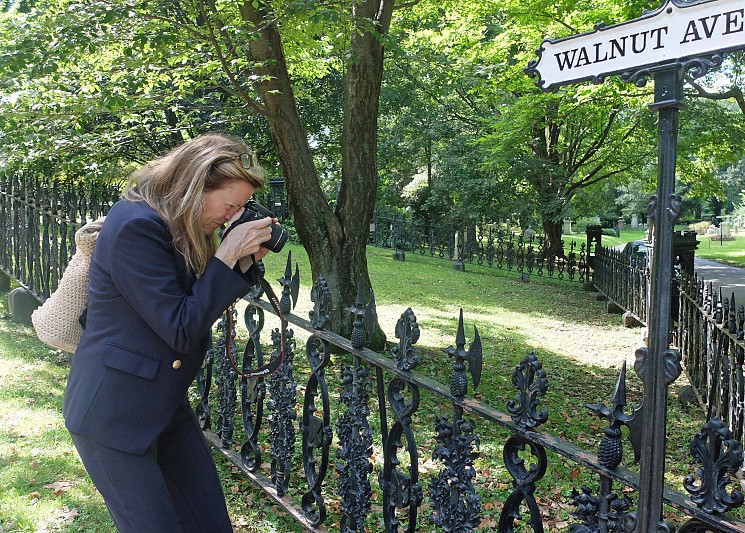
In the mid-19th century, family lots were often decorated in a similar fashion to one’s home or front yard. It was especially popular for proprietors to enclose their lots with fences, and by the 1860s more than 1,700 of them dotted our grounds. But the trend of iron fence art was short-lived, and in the 1870s a movement to remove them began. Mount Auburn has 62 fences remaining in our landscape today – 60 historic and 2 new – and we are committed to their preservation. I sat down with Curator of Historical Collections & Archives Meg L. Winslow to discuss this unique part of our landscape and history.
Anna:
Cast and wrought iron fences are not common elements of modern-day burial lots. Can you bring us back to the mid-19th century and talk about the motivations of the people who commissioned these fences?
Meg:
Yes, lot fences add another layer of ornament to the landscape. Right from the beginning, the aesthetic at the time was to enhance the beauty of the grounds with “tasteful” ornament. We often talk about integrating nature and art at Mount Auburn, and today, as it did in the 19th century, ornament in its many forms contributes to the artistry found on the grounds. In fact, the word “ornament” can be found in our founding documents to describe the establishment of Mount Auburn as “an experimental garden and an ornamental cemetery,” with improvements within lots to be made only “for the purpose of utility and ornament.” Today as you walk through the landscape, you’ll find fences and curbing, settees and chairs, urns and vases, and even a hitching post for horses. Imagine how much ornament there was in the Victorian age!
At Mount Auburn there exists a kind of duality of function and ornament. The lot fences, for example, were erected to keep horses off the lots and mark boundaries, but they could also be beautifully designed works of art in themselves. Along with fences, decorative items like benches, urns, and seats were added to the 19th-century landscape to create a more ornamental appearance. The result was familiar, like a front lawn or domestic parlor space. The Cemetery placed cast-iron settees near Bigelow Chapel and the entrances, and many additional iron benches and seats were placed in individual lots by their owners. The effect, while welcoming and comfortable, eventually created a more cluttered landscape, and of course iron needs continuous priming and painting.
Anna:
How did people’s feelings about these fences evolve over time?
Meg:
The general taste of the lot owners changed from those first decades, quite quickly. By 1875, lot proprietors were requesting that no more fences be allowed. In our Archives, we have letters from lot proprietors to the Cemetery as well as copies of letters from the Cemetery to proprietors offering to remove fences “at no extra charge.” The general feeling was that Mount Auburn had become too crowded and too cluttered – like a patchwork quilt – and the original rustic beauty of the landscape was being lost. Also, at the time, families were responsible for maintaining their own lot fences, and when they were not painted, the iron began to disintegrate. Most of the lot fences were removed before 1900, along with most of the cast iron chairs, and non-commemorative settees, urns, vases, and statues from individual lots.
But you know, we have to be careful here; not every lot owner wanted their fence removed! The lot fences that remain today are here because they were saved by those individuals who said “please don’t remove my fence.” I mean, there are letters, year after year, from the Cemetery to lot owners saying we would be happy to “take your fence down at no charge,” and lot owners had to really assertively reply: “I love my fence – here is $5 to paint it.”
Mount Auburn’s 4th President Israel Spelman addressed the issue of removing “old fashioned lot fences” still in the landscape when he said in 1875 that in Mount Auburn, we should expect to find all these different things embodying the changing feelings and tastes of different periods. He wrote of his appreciation of the diversity of ornament that had been placed in our landscape over time, and his vision was to remain a cemetery that reflected this evolution.
Anna:
What are some of the common ornamental motifs found in Mount Auburn’s lot fences, and what do they signify?
Meg:
You can find some great examples of symbols in the Tisdale-Hewins fence right off Central Avenue (Hyacinth Path, Lot 1080). There are pineapples, a well-known symbol of hospitality, and on the gate, there are two downturned torches, crossed, with a laurel wreath. The downturned, or inverted, torch is an ancient Greek symbol of death and mortality. The laurel wreath, which is evergreen, symbolizes immortality and victory over death. This is one of our earliest custom-designed fences. We know who designed it – architect Theodore Voelkers – and an engraving of his design was published in the 1847 guidebook about Mount Auburn, Mount Auburn Illustrated. By the way, the far-sighted Tisdale and Hewins were two of the first lot owners who paid for a perpetual care contract for their fence.
And of course, there’s the unique design of the Cogswell lot fence (Central Avenue, Lot 1142) which marks the boundary of a smaller triangular-shaped lot nearby. All along the lower border of the cast-iron fence panel, there is a repeated circular shape consisting of three parts that look like water drops, a little like a three-part yin-yang symbol. This universal symbol is known as the world triad symbol, dynamic and signifying life in motion. If you look more closely you’ll discover it in the design of the marble monument as well! The fence dates before 1865, so it too is an example of an early fence at Mount Auburn.
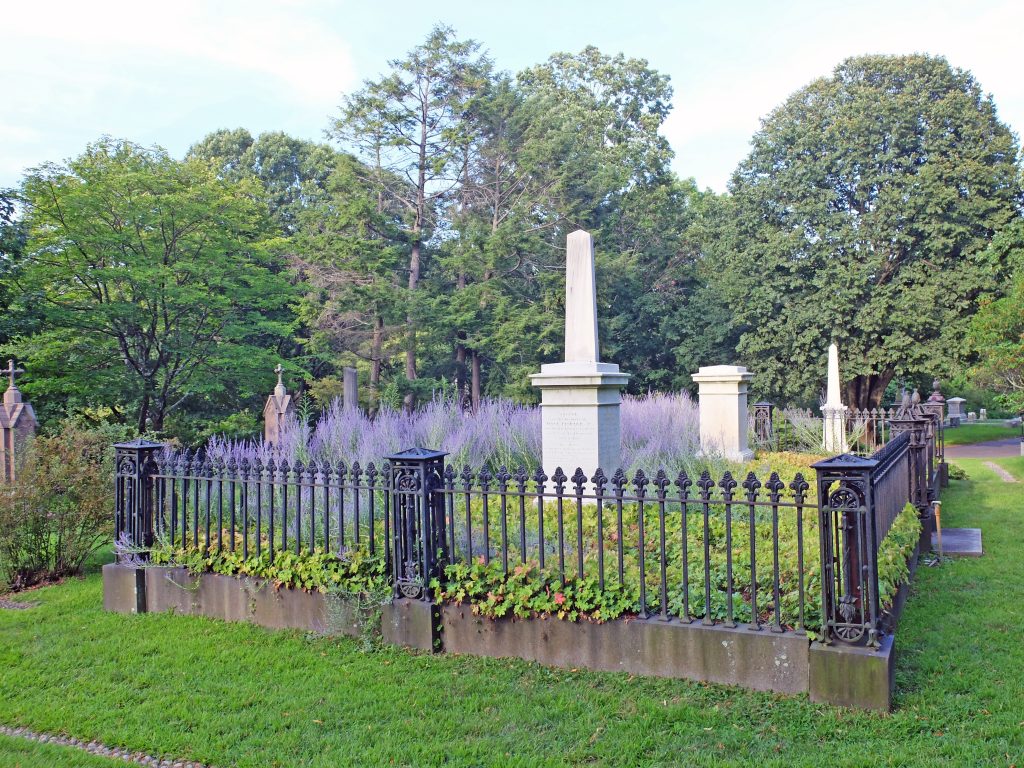
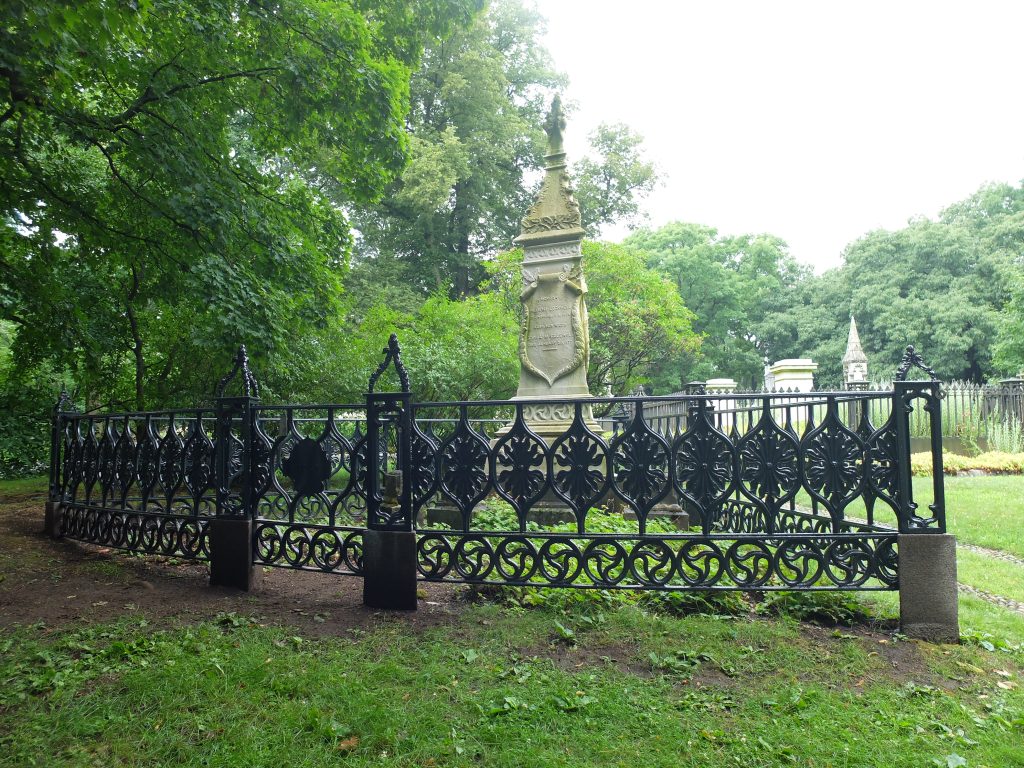
Anna:
One of the most remarkable examples of ironwork at Mount Auburn is the Scots’ Charitable Lot fence (Fir and Walnut Avenues, Lot 816). Could you talk about its history and some of the preservation work it will need in the near future?
Meg:
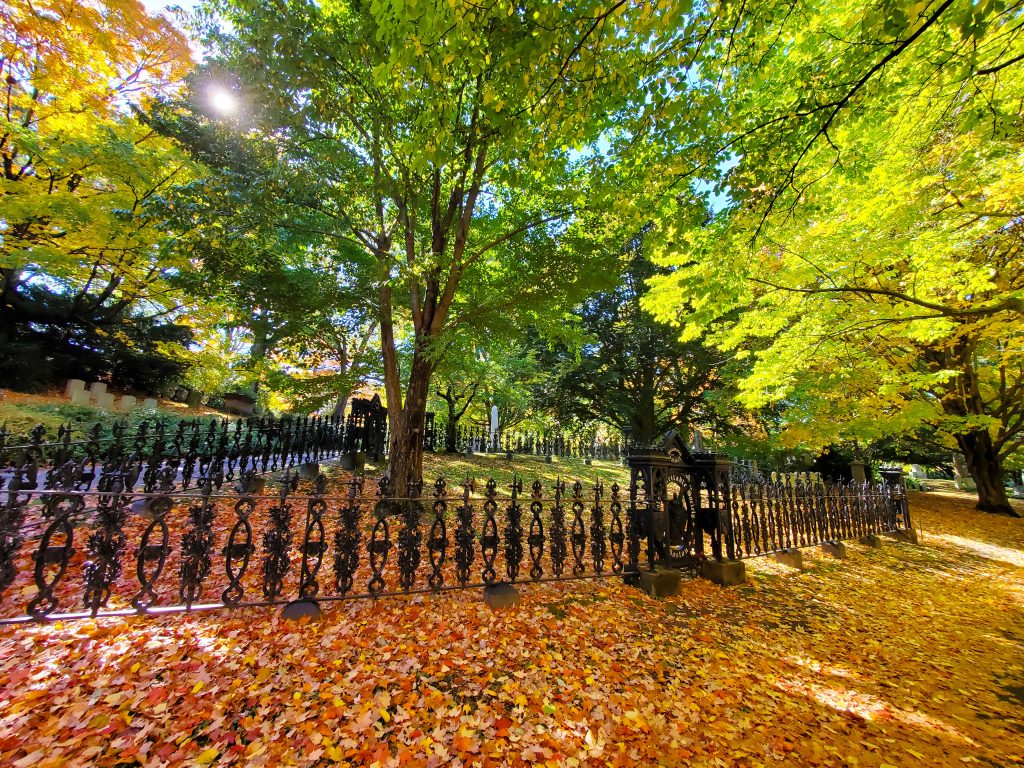
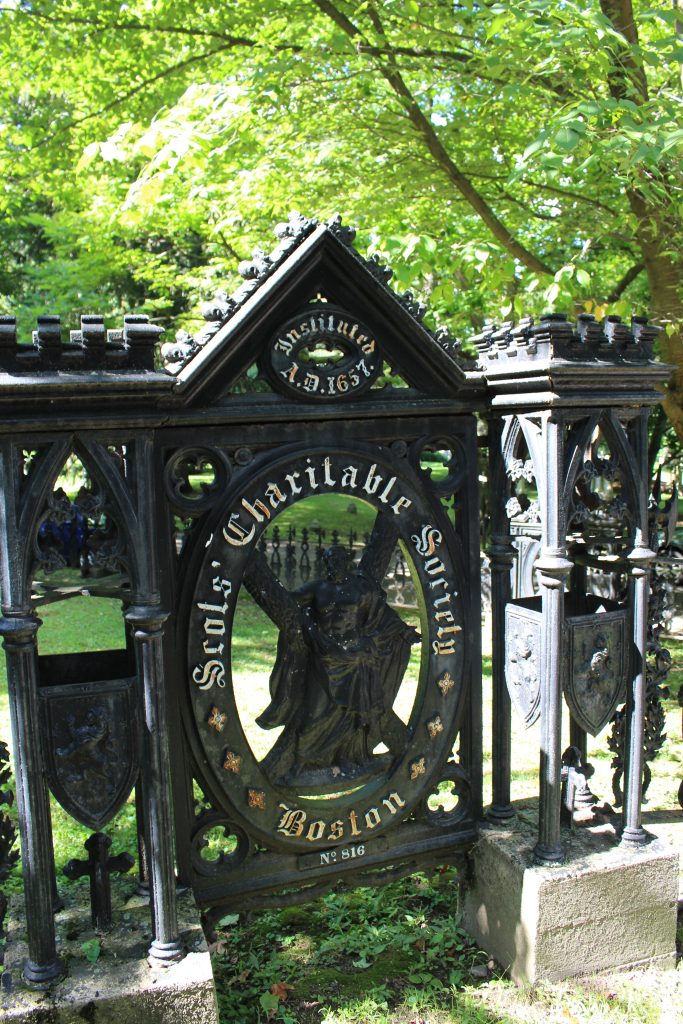
Absolutely! It’s just magnificent and one of the most significant works of art at Mount Auburn. Designed by the Boston architect Theodore Voelkers, and made by David Miller, the large lot fence was completed in 1847. Saint Andrew, patron saint of Scotland, is depicted on the gates in robes with a wooden Saint Andrew’s cross. And the fence is adorned with symbols of Scotland – wonderful thistles, battle axes, rampant lions, and shields.
The large, pie-shaped lot has no headstones, so this remarkable fence serves as the memorial for the more than 200 people buried in the lot. The Scots’ Charitable Society is the oldest charitable society in the United States and offered burials for those who did not have the means to pay for the expense of burial at Mount Auburn. Today, the Scots’ Charitable Society lot is one of our most beloved, and the fence is our most significant fence in need of preservation. The deterioration of the granite bases that hold up the heavy fence threaten its stability, and the cast iron needs repair and repainting. It will be a complex and expensive but essential restoration project.
2024 Update: Thanks to our donors in 2022 for matching a National Trust for Historic Preservation grant to complete an assessment of the Scots’ Charitable Society Fence, which revealed the extent of the damage to this iconic landmark. Now, Mount Auburn is fundraising for the preservation itself and we need your help! If you treasure local history and would like to make a change, please donate below. Read more >>
Anna:
Can you talk about your experience with Mount Auburn’s fences during your time here?
Meg:
When I first came to Mount Auburn in 1993, I was drawn to the monuments, their forms set within the landscape, and their visual language. I then discovered many more structures within the grounds – fences, vases, urns, retaining walls, steps, and benches, to name a few. These landscape furnishings ornament the landscape but are easy to miss. The experience of walking through Mount Auburn with the extraordinary trees and plants, the wide range of memorials in all shapes and sizes, and the abundant wildlife that so often catch our attention, prevents us from appreciating this additional layer of ornament that was so integral to the 19th-century design of the Cemetery.
That’s what I want people to see as they walk in our landscape too, that there’s more than trees and memorials to be admired. It’s like that in-between zone that people don’t think about. I love showing others something that they walk past all the time, that they didn’t remember seeing before. It’s a beautiful moment of discovery.
Anna:
Do you have a favorite fence at Mount Auburn?
Meg:
I do. In fact, I have two favorites – one older, and one that is contemporary. The Lowell lot fence (Willow Avenue, Lot 217, West) is an extraordinary early example from 1847. In the Egyptian Revival style, popular in the early decades of Mount Auburn, it exudes pure wrought-iron simplicity and proportion. Jumping ahead, my other favorite is the fence above Narcissus Path for the Mitchell lot (Narcissus Path, Lot 384) which was designed by Peter Andruchow in 2002.
I now realize that both these fences have botanical designs! The lotus flower design of the Lowell fence is repeated on the picket tops of the fence. And the design of the Mitchell fence centers around the hosuge flower, a stylistic representation of a flower from Japanese textile designs, in a repeated oval pattern. Each flower in the Mitchell fence is composed of 27 pieces, and each petal was hand cut – an incredible amount of work! Again, it looks so simple, but when you keep looking at it, you see that it’s a very complicated design. It’s just a gorgeous fence, and because of its natural beauty, just integrates seamlessly into the landscape. These two fences bring ornament to Mount Auburn with permanent flowers in the landscape!
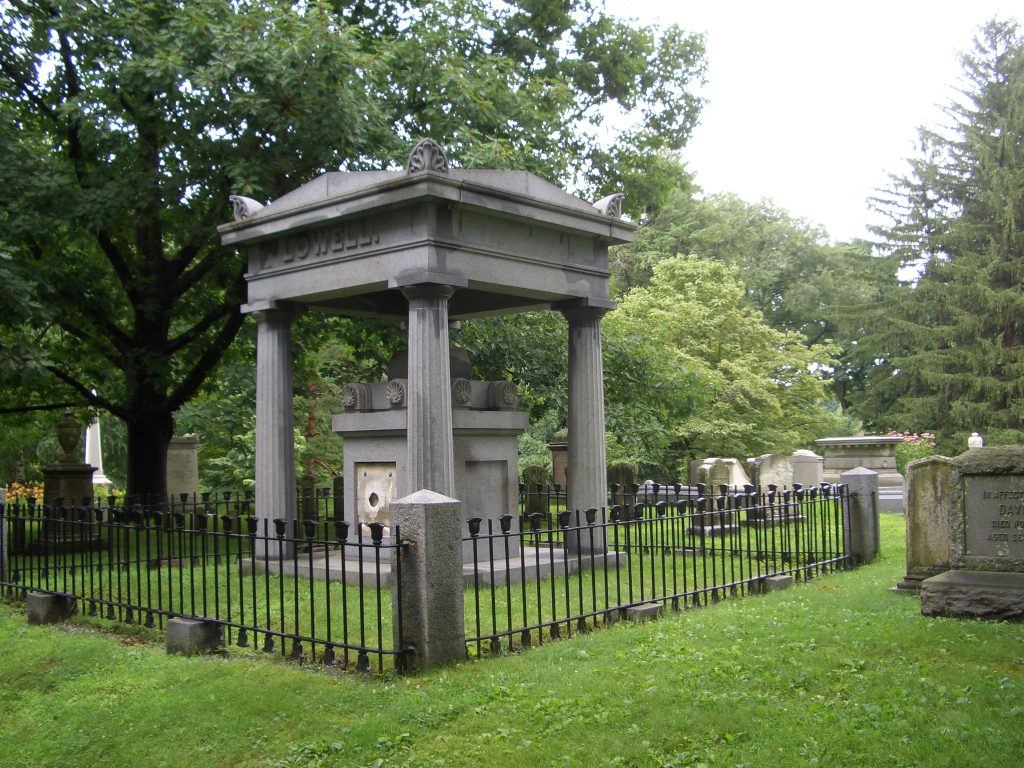
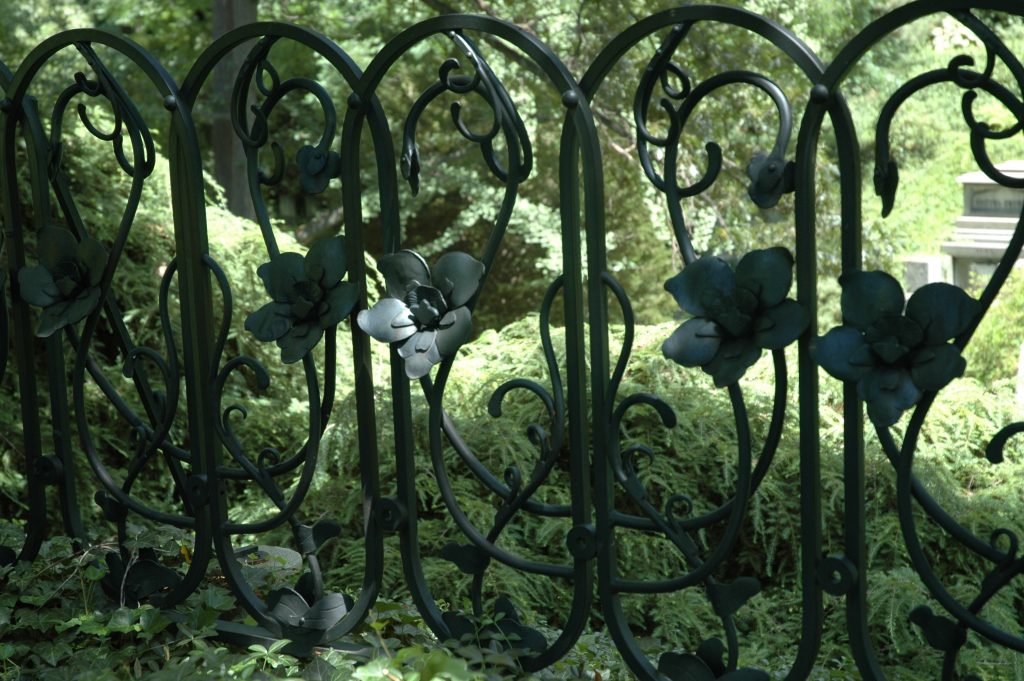
Leave a Reply